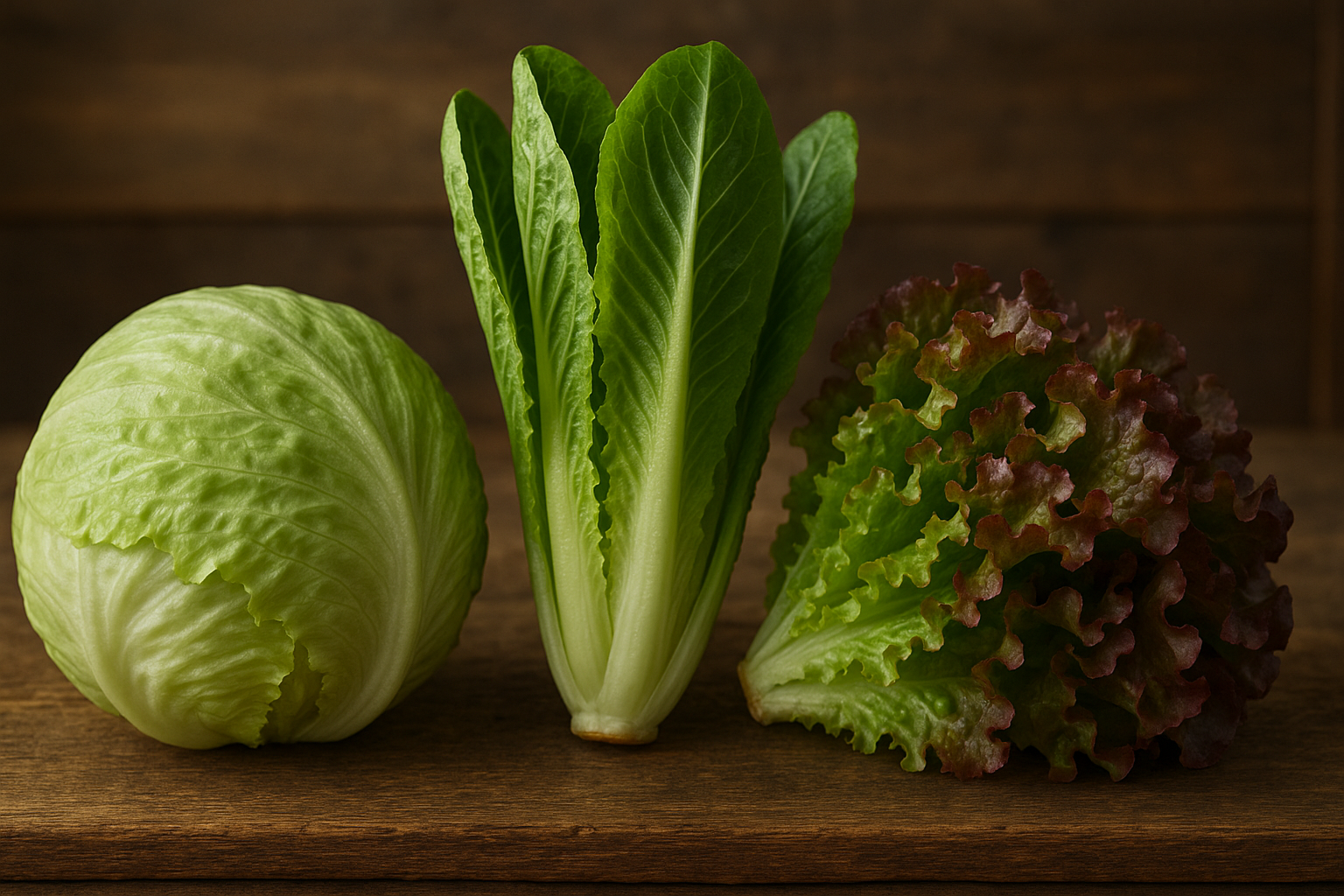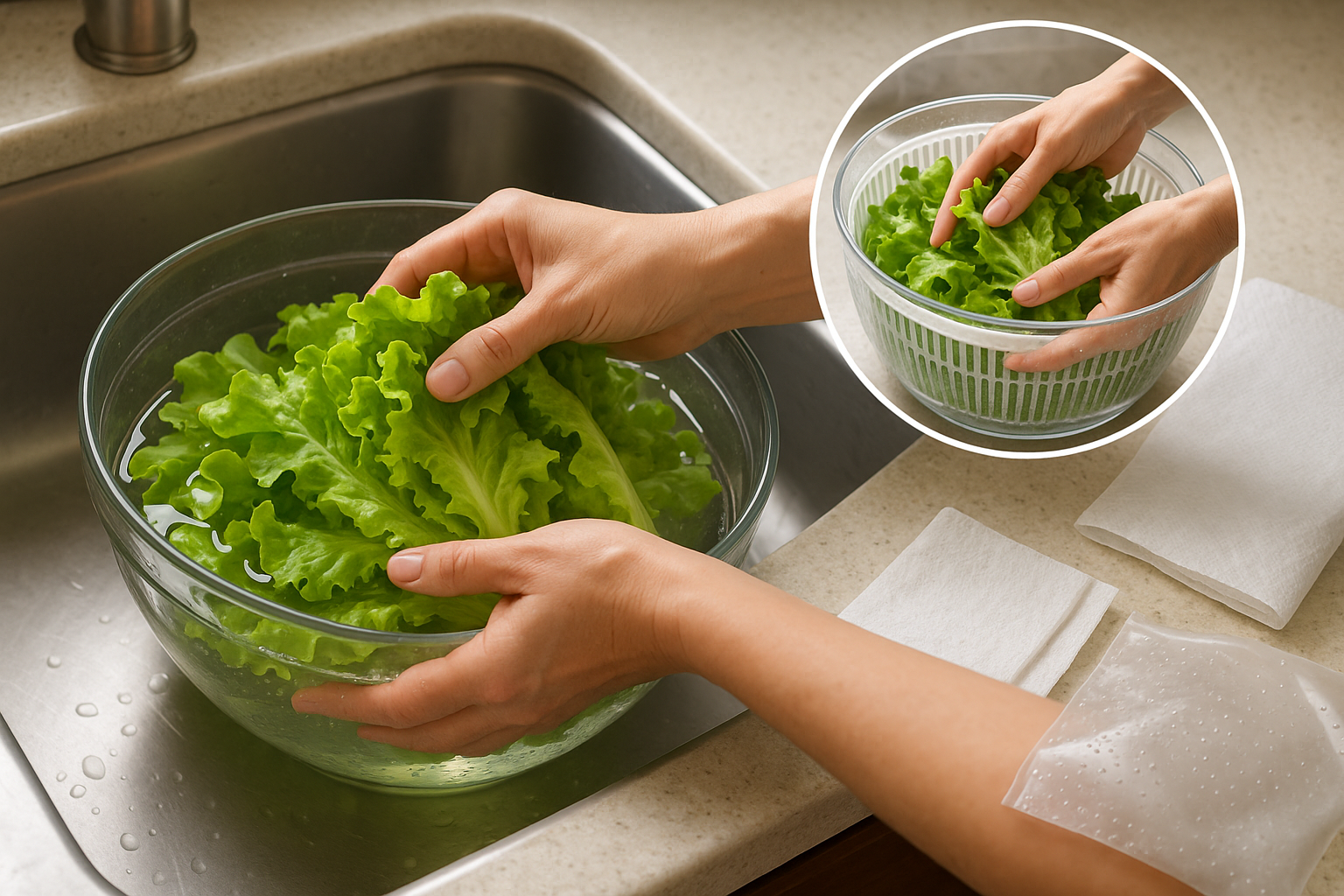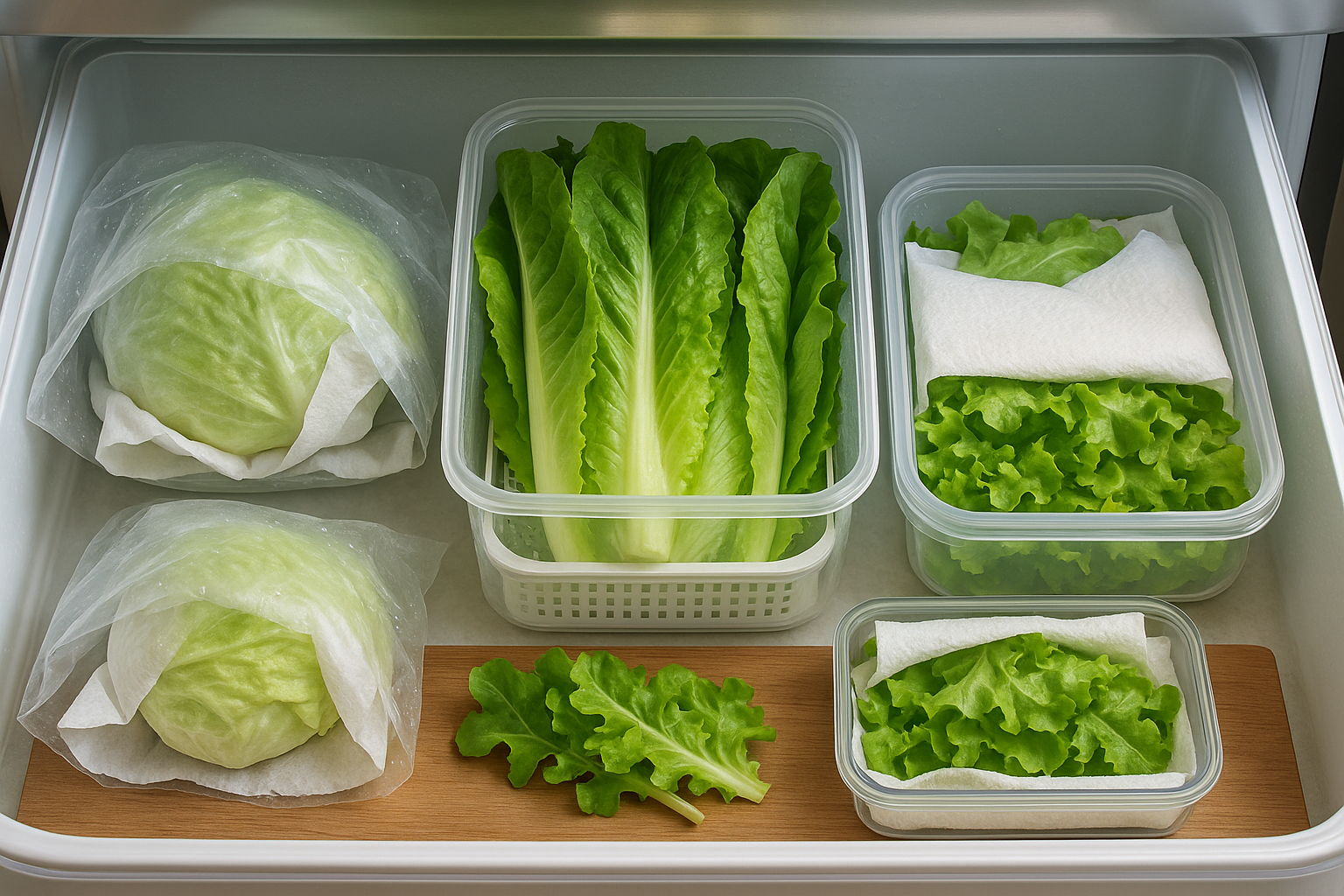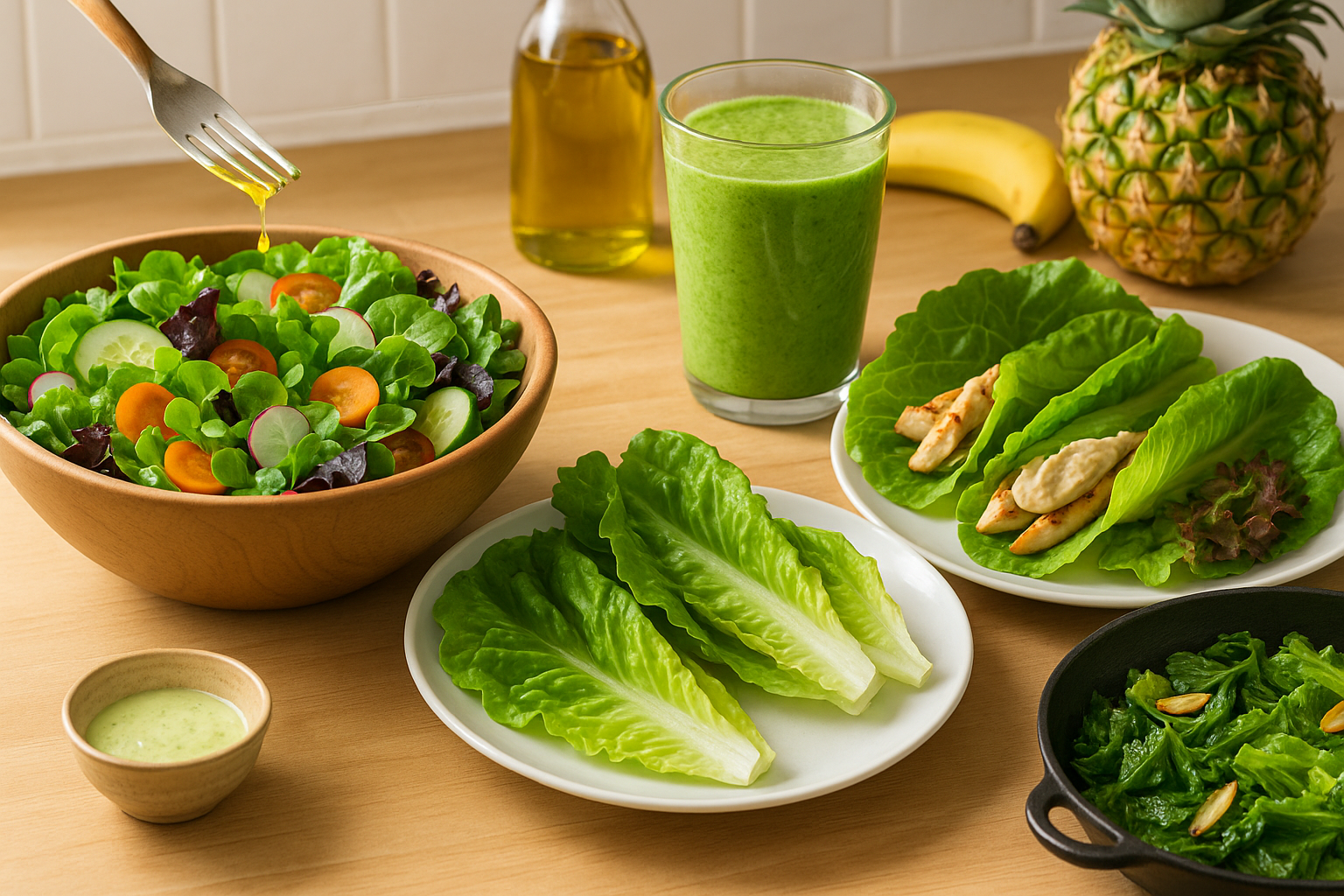Understanding Lettuce Varieties and Their Storage Needs

Freshly harvested lettuce spoils quickly because it is mostly water—up to 95%—and has delicate cell walls that break down with mishandling or poor storage. Exposure to air causes wilting as moisture escapes, while bacteria and fungi can trigger decay if there’s too much humidity or damaged leaves.
The main types of lettuce—iceberg, romaine, and loose leaf—each have unique textures and structures that impact how they should be stored.
Iceberg Lettuce
Iceberg lettuce forms tight, dense heads with crisp leaves that act as natural barriers against dehydration, making them the most resilient. They can last in the crisper drawer for up to two weeks if wrapped loosely in paper towels inside a breathable bag.
Romaine Lettuce
Romaine lettuce features long, upright leaves with sturdy midribs—they’re crunchy but more exposed to air, and the open shape means they dry out faster. To extend freshness, separate and wash the leaves, dry them thoroughly, then store in a ventilated container lined with a dry towel.
Loose Leaf Lettuce
Loose leaf varieties, like green or red leaf lettuce, have the least structure and wilt fastest, sometimes within days. Their thin, tender leaves need extra care: avoid crushing them, always pat leaves dry before storage, and layer with paper towels in a container or perforated bag to reduce trapped moisture and prevent rot.
By recognizing variety-specific traits, you can fine-tune your storage routine—keeping salads crisper, leftovers fresher, and reducing unnecessary waste.
Preparing Freshly Harvested Lettuce for Storage

After picking lettuce from your garden or receiving it from a local market, handling it with care is crucial to keep it crisp and fresh. Start by filling a large bowl or clean sink with cool water, then gently swish the lettuce to remove any dirt or insects—avoid using forceful water streams that can bruise the leaves.
Remove any wilted or damaged outer leaves, as they can accelerate spoilage. Once clean, thoroughly dry the lettuce since excess moisture leads to soggy leaves and faster rot. Use a salad spinner if you have one, or gently pat the leaves dry with a clean kitchen towel. Some gardeners like to layer the leaves between two towels and give a little shake—just be careful not to crush them.
When it comes to storage, keep whole heads intact for the longest lifespan; wrap them loosely in a dry paper towel and place them inside a perforated or open plastic bag in your crisper drawer. If you prefer portioned lettuce for quick salads, dry and cut or tear only what you need, storing bite-sized pieces in an airtight container lined with paper towels to soak up any lingering moisture.
Remember, gentle handling every step of the way—from rinsing to drying to storage—not only preserves the delicate structure of the leaves but also extends the time your lettuce stays garden-fresh and ready to eat.
Effective Storage Methods for Long-Lasting Freshness

When it comes to keeping lettuce crisp and flavorful longer, your storage method can make all the difference.
For loose leaf lettuce, one of the most reliable tricks is the paper towel-in-bag method. After gently washing and drying your leaves (a salad spinner works wonders), layer them between clean paper towels to absorb any excess moisture. Then, place everything in a zip-top bag or reusable produce bag, pushing out as much air as you can before sealing. This approach is well-loved by home cooks and frequently recommended by experts for preventing sogginess without drying out the leaves.
Another smart option is using an airtight container: line the bottom with a dry paper towel, arrange the lettuce loosely inside, and top with another towel before sealing. This method is especially helpful if you prep salads in advance, as it keeps leaves crisp and ready to use for up to a week.
If you want truly specialized storage, consider a produce keeper—a container designed with vents and moisture trays to create the perfect environment for greens. Simply place cleaned, dried lettuce inside and adjust the vent, following manufacturer instructions. Home trials have shown that produce keepers can keep lettuce noticeably fresher than standard containers.
For whole head lettuce, try the “puff of air” method: after wrapping your rinsed, dried head in a paper towel, slip it into a large bag (like a gallon ziplock), blow air inside to create a loose “balloon,” then seal. This air cushion limits crushing and moisture buildup, reducing spoilage. Many seasoned gardeners swear by this technique for heads of romaine or iceberg.
In summary, use paper towel and container methods for loose leaves, while whole heads benefit from a little protective airflow. Whichever technique you choose, always start with dry, clean leaves—excess moisture is the enemy of freshness! With just a few extra minutes of prep, you can enjoy crisper, tastier salads all week long.
Special Tips for Different Types of Lettuce
Storing lettuce correctly makes a big difference in both taste and shelf life, but it helps to know the unique needs of each variety.
Iceberg Lettuce
Iceberg lettuce, with its dense, crisp heads, holds up best unwashed and whole. Wrap it loosely in a dry paper towel and place it in a perforated plastic bag or a lettuce-specific container in the refrigerator. This method maintains crunch while preventing excess moisture that causes browning.
Romaine Lettuce
Romaine, with its long, sturdy leaves, should also be kept unwashed until you’re ready to use it. Remove any damaged outer leaves, then store the head or individual leaves in a breathable bag—such as a reusable produce bag or a container with a vented lid—layered with paper towels to absorb condensation.
Loose Leaf Lettuce
Loose leaf varieties, like red leaf or butter lettuce, are more delicate. Separate and gently pat dry any leaves you want to save, then spread them in a single layer on top of paper towels before loosely wrapping and placing them in a large airtight container.
General Storage Tips
- Avoid sealing lettuce tightly in non-vented plastic, which traps humidity and promotes sogginess.
- Don’t pre-wash lettuce unless you need it ready to eat. Always let washed lettuce dry thoroughly before storing to prevent wilting or rot.
- Give your greens a little airflow by avoiding cramming lettuce into a crowded drawer, which can cause premature spoilage.
- If your lettuce comes pre-bagged, remove any excess water and place a sheet of paper towel inside the bag to absorb moisture.
- Keep lettuce away from ethylene-producing fruits like apples or avocados, as ethylene speeds up spoilage.
With just a few thoughtful tweaks for each type of lettuce, you’ll keep your greens fresh, crisp, and ready to enjoy all week.
Maximizing Storage Life—Bonus Tips and Common Mistakes
Getting the most out of your produce starts with a few smart storage tweaks that make a big difference. Use your crisper drawer strategically: keep it only two-thirds full and adjust humidity settings (high for leafy greens, low for fruits) to avoid spoilage.
For items like carrots or celery, try a simple hack—store them in a container of water in the fridge to keep them crisp and vibrant. Always remember that whole fruits and vegetables last longer than cut ones, so only chop what you need and store the rest whole to slow down spoilage.
If you find leafy greens starting to wilt, don’t toss them—rehydrate by soaking in cold water for 10-20 minutes to bring back their crunch.
Be mindful of common mistakes such as over-packing your fridge, which restricts airflow and encourages mold, or using containers that don’t allow produce to breathe, leading to condensation and decay. Paper towels in storage bags help absorb extra moisture and keep produce fresher longer.
Forgetting to label your foods is another pitfall—use masking tape or sticky notes to mark storage dates, so you can rotate items and avoid the mystery-bag syndrome at the back of the fridge.
These quick, practical steps extend shelf life and keep your ingredients at peak quality longer, saving you both food and money.
How to Tell When Lettuce is No Longer Fresh
Knowing when lettuce has gone bad is key to enjoying safe and tasty meals. The most obvious sign of spoilage is a sour or rotten odor—fresh lettuce should have a neutral, earthy scent. Pay close attention to texture as well; leaves that feel slimy, soggy, or mushy are red flags and should be discarded immediately.
Other warning signs include brown or black spots, wilting, and visible mold, all of which indicate decay. Always throw away any leaves that are discolored, slimy, or smell off, as consuming spoiled lettuce can lead to foodborne illness.
If only a few outer leaves appear spoiled while the inner leaves are crisp and healthy-looking, you can salvage the good portions by removing and tossing the damaged ones, then rinsing the rest thoroughly under cold water. However, if the entire head or bag looks affected—or if you’re unsure—it’s safest to discard it all.
Never eat lettuce that has an off-putting odor or feel, as harmful bacteria can hide in these signs of spoilage. Practicing these checks each time you prepare lettuce helps keep your meals both fresh and safe to eat.
Quick and Tasty Ways to Use Stored Lettuce Before It Spoils

Don’t let that bag of lettuce sit forgotten in your fridge! There are plenty of quick and tasty ways to use up stored lettuce before it goes bad. Start with the obvious—toss crisp leaves into salads with whatever veggies or proteins you have on hand, then drizzle with your favorite vinaigrette.
For an easy lunch, turn large lettuce leaves into wraps filled with grilled chicken, hummus, or leftover roasted veggies for a crunchy, satisfying bite. Slightly wilted lettuce doesn’t have to go to waste; blend it into green smoothies with fruit like banana, pineapple, or apple to add nutrients without altering the flavor much.
If the greens are nearing the end, chop them into soups or stir-fries. Lettuce wilts quickly and adds a mild, pleasant taste, especially in Asian-inspired broths or omelets. For a creative twist, try sautéing lettuce with garlic and olive oil—or layer it into sandwiches and burgers for moisture and freshness.
To extend lettuce’s life, store it in the crisper drawer wrapped in a paper towel to absorb excess moisture—this simple trick keeps the texture crisp, making it more appealing in every dish. Making the most of your lettuce not only saves money but also helps cut down on food waste, one delicious meal at a time.